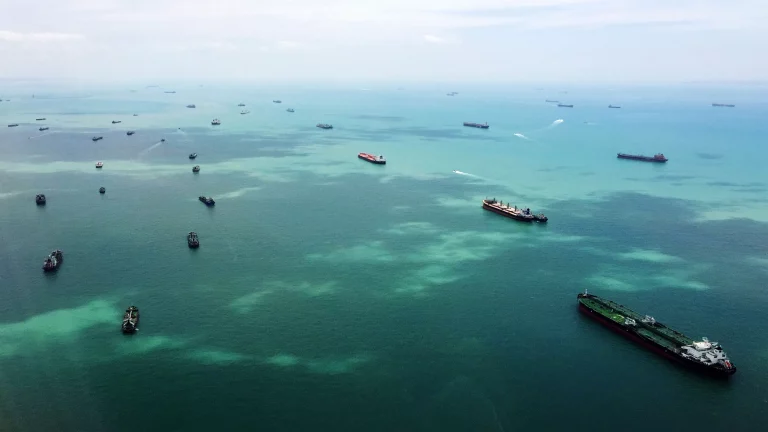T he trade dispute between the US and China continues to escalate. Tariffs of 25% have been imposed or announced on $50 billion of imports from China, and tariffs on a further $200 billion are now being reviewed. China has retaliated against the first round of US tariffs and has vowed to continue to do so in response to any further US action. A number of other trade relationships, from steel and aluminum to NAFTA and the US-EU automotive trade, are seeing tensions as well. With some of the world’s largest trading relationships embroiled in an escalating trade conflict, how high might the cost to the global economy and to your firm be?
Business leaders get divergent signals on how worried they should be. On the lower end are assessments like those from Goldman Sachs, which sees the tariffs announced so far shaving off only about one to two basis points from US GDP. The World Bank found that even a widespread increase of tariffs would reduce global GDP by less than 1%, even though global trade would drop by close to 10%. On the higher end is the Bank of England , which sees escalating trade protectionism and its repercussions reducing US GDP by 5% and global GDP by around 2.5%. Financial markets are clearly concerned but alternate between short-term dips when new policy actions are announced and quick recoveries once quieter conditions (but not lower tariffs) are restored.
How should business leaders make sense of these conflicting views? We argue that the differences in predictions are mostly a sign of differences in the scope of impact assessed, not of fundamentally different views on how tariffs affect trade. But where they all fall short is in their lack of focus on those metrics that matter most to individual firms. We offer nine observations on trade policy impact analysis for firms and then lay out four implications on how executives can respond.
We argue that the differences in predictions are mostly a sign of differences in the scope of impact assessed, not of fundamentally different views on how tariffs affect trade.
Observations About Trade Impact Analysis
A small welfare loss overall could mean a huge profit or loss for your firm.
Trade policy impact analyses tend to focus on welfare losses as the result of a higher tariff. They talk much less about individual winners and losers. If a tariff is imposed, the net welfare losses tend to be modest—they are measured by the reduction in consumption times half of the tariff. But individual gains and losses can be substantial. Government and domestic producers gain while consumers and the firms subject to the tariff suffer. And this redistribution of value can be very significant—measured by the tariff times all remaining trade and by the consumer price times the change in market share.
Take as an example US steel tariffs. The Department of Commerce reported in its Section 232 investigation on steel a current market share of imports of about 33% of US demand (by volume) and suggested a 25% tariff to reduce this market share to 22% while dampening US final demand by about 4%. The welfare loss is given by half the tariff rate (25% / 2 = 12.5%) times the reduction in consumption (4%) = 0.5% of market revenue. The amount of value shifted around, however, is a multiple of this amount. Foreign producers lose one-third of their sales, equivalent to about 10% of market revenue. Some of this shifts to US producers, some of it manifests itself in lower market activity. Foreign producers also lose profits to the US treasury given the lower prices they have to accept net of tariffs for their remaining sales, equivalent to 22% of the market. If their margin drops by, say, 2 percentage points, that alone would be similar in absolute terms to the total loss of welfare. Local producers earn market share. And they benefit from a higher margin on their entire sales, equivalent to 80% of the market, as consumers have to pay higher prices.
A more exact analysis would look at the granular data on market dynamics, prices, margins, and the like. But while the specific numbers will change, the broader point holds: the shift in market shares and profits is much larger than the net welfare loss. And for individual firms it is these changes in market share and profit that matter.
The shift in market shares and profits is much larger than the net welfare loss. And for individual firms it is these changes in market share and profit that matter.
Tariffs matter because they shift value around; in fact, that is their very purpose. Firms should not get confused by the small aggregate numbers of trade impact assessments.
Trade analysis (often) assumes one-step trade; companies live in a world of global value chains.
Trade impact analysis tends to model trade as a good produced in country A being sold for consumption in country B. A tariff creates a price wedge between what consumers pay and what producers earn, reducing trade and shifting economic activity to where the market is.
However, an increasing share of global trade follows a different dynamic. The many different steps through which goods are produced are often fragmented across different locations, creating so-called global value chains or nets. The development of these global value chains has been a key driver for world trade to grow much faster than world GDP—the same goods are moved across borders (and counted as trade) many times before they reach the final consumer.
In a global value chain, tariffs play out somewhat differently from the traditional model. A tariff makes a location less attractive because it raises import costs. Both imports and exports will fall. This can shift production away from the country that is “protecting” its producers, in particular when other countries retaliate and impose tariffs of their own on the final product. Global value chains also provide opportunities for firms to avoid tariffs by relocating individual activities. Tariffs then fail to “protect” the entire value chain and benefit only the small set of activities that need to be in a located in the market concerned for the tariff to apply.
The global automotive industry is a poster child for global value chains and shows how these dynamics play out. Many European producers have US factories from which they serve Asian markets, drawing on European parts and components. A US tariff could easily undermine this model, even more so when China reacts by imposing further tariffs of its own. This would make the US less attractive as a production site, not more. The global automotive industry has a long tradition in managing tariffs: producers sometimes export ready-to-assemble kits to markets with high tariff protection for finished cars, creating minimal value-added in these markets themselves.
Firms should assess their exposure along the value chain and review their options to respond as trade policies change. They will be affected by tariffs in many supplier industries, not just their end-product market. Global value chains create more exposure but also more flexibility. Firms with a larger global footprint will be advantaged through their broader ability to respond to changes in trade policy conditions.
It is not the tariff rate that matters most, but the market elasticities.
It is the tariff rates and the value of the trade affected that make the headlines on trade policy. But how they affect firms in the markets in which they are applied depends significantly on the demand and supply elasticities. How much of the tariff can be pushed over to customers? How easily can domestic producers step in and take market share? Are there third-country producers that are not covered by the tariffs and might be able to step in?
This affects the overall welfare gains but, more important, has dramatic implications for how economic value is redistributed among consumers, domestic and foreign producers, and the government. A high tariff in a market with low elasticities matters little to firms; it just taxes local consumers. A low tariff in a market with high elasticities, however, can dramatically change market shares.
This bias also affects the metric often used to measure protectionism : trade-weighted average tariffs. Here the level of protection is assessed by the level of trade that still occurs, not by the level of trade that has not taken place because of the tariff.
Firms should deploy their deep understanding of the market dynamics that they are exposed to and not get distracted by the nominal tariff rates. Firms with attractive (that is, differentiated) positions in attractive markets (with high entry barriers, high switching costs, products critical for consumers, and the like) will suffer the least.
Tariffs are a visible sign of protection, but non-tariff barriers have an increasingly more powerful impact on competition.
Tariff rates are transparently laid down in official rules and regulations, setting rates for very narrow product categories. The reduction in tariff rates over the past couple of decades has been very visible and has symbolized the reduction of trade barriers that has been achieved.
While tariffs have become less of a burden, the role of so-called non-tariff barriers that arise because of different rules and regulations across countries has grown. These non-tariff barriers include a wide range of policies , from local content requirements to health and safety standards. In a world of global value chains, investment regulations, including dispute settlement mechanisms that give foreign investors recourse against home country policy decisions, are part of this set of rules that matter. They are called barriers, but unlike tariffs they cannot be simply eliminated; they reflect issues that governments have a fundamental responsibility to organize in some way irrespective of trade.
Firms need to be aware of the impact that these rules and regulations have on their costs as well as on their competitive position relative to rivals. Contrary to tariffs, there is no profit shifting to governments, but there are costs from meeting specific national requirements. The complexity of these rules is in itself a cost, and often one that larger firms are better positioned to manage.
Adjustment can be costly but is usually not included in assessments.
Economic models tend to compare equilibrium situations: what does the world look like now, and how will it look like with the tariff(s) in place? This is a reasonable approach, especially when looking at aggregate changes in welfare. But it can miss significant adjustment costs as value (and production) is shifted around. It can understate short-term implications, for example the temporary over- and under-shooting of investment across different locations as companies adjust their production footprint to a new trade policy environment. And if decisions about costly adjustments have to be made in an environment where the long-term trade policy context is uncertain, it might lead to a backlog of postponed investments with consumers paying higher prices in the meantime.
As an example, think about the highly integrated US-Canadian automotive industry in the Great Lakes region. Building new plants in the US and training a new workforce will take time and resources. It will also lead to economic fluctuations: Assume that the current capital stock across the US and Canada is divided 80:20. With higher trade costs, that optimal division might now shift to 85:15. This implies not only that Canadian automotive investment drops by a quarter from now on. It also means that in the intermediate period investments in Canada will drop by even more until the lower new capital stock ratio is reached. And if US producers are unsure about the level of capital stock they should have in the US longer term, their investment in the US might not fill the gap with higher prices and lower output as the result.
Firms need to analyze the relevant adjustment path of the economy and what it means for them, and not just look at the potential new end state. Long-term market elasticities tend to be higher than short-term elasticities. Short-term movements in prices and investments might overshoot their long-term levels. And any adjustment requires investments to be made. Firms need to ensure that they have the resilience to manage these fluctuations.
Benefits from tariff protection are not a windfall—they come with expectations attached.
Tariffs are generally imposed with the purpose of increasing domestic production and employment, not to generate tariff revenues or create profits for domestic firms. But in most economic models, the tariff revenues do play a significant role in making protection a potentially welfare-enhancing policy intervention. Beyond that, policy makers hope that protection will encourage domestic producers to shape up and become more competitive.
The evidence on whether this actually happens seems to depend on local market conditions as well as the performance gap between domestic and foreign producers. The critical view of traditional industrial policy was the result of many cases in which the benefits from protection or government support were not invested in creating more competitive firms. Concerns about Chinese industrial policy are conversely driven by the view that government subsidies and a protected home market have enabled Chinese firms to build a war chest that they are investing in market positions and technological leadership.
Firms benefiting from tariff protection thus need to embrace a two-step task: First, exploit the change in market context to enhance current profits through a combination of gaining volume and raising margins. Second, decide whether to invest in strengthening capacity and capabilities with a view to compete more successfully in the future, with or without protection. The expectations from policy makers will be that firms raise volumes and invest. This might not always be the profit-optimizing choice. Firms need to be aware of the political repercussions of their choices.
Protectionism alone will not trigger a global recession, but its macroeconomic repercussions could.
The overall loss in global GDP predicted by traditional models from even a substantial increase in tariff rates is meaningful but far from dramatic. Studies to model a breakdown of the WTO system with all countries moving to non-cooperative tariffs predict average tariffs to rise to between 35% and 60% . Global trade would suffer, but global GDP would drop by only 3%. Countries with higher trade exposure would be hit harder—this was also true during the global financial crisis—but these also tend to be economies with higher competitiveness that are able to recover more quickly.
So is the fear unfounded that protectionism could trigger global growth to stumble? Not entirely. It will depend on how protectionism shapes the broader view investors and financial markets take about the future, and what repercussions their actions might have. Investment reluctance due to higher uncertainty could reduce momentum. Expectations of rising inflation due to higher import prices could lead to a tightening of monetary policy that slows growth. And a higher pricing of risk could lead to substantial redirection of financial flows, for example out of emerging economies that are more reliant on trade and generally more volatile. These macroeconomic repercussions are the reasons central banks and international organizations come to more pessimistic assessments of the impact that a trade war could have. In fact, the Bank of England assessment views such secondary effects to weigh much more on the UK economy than the direct effect of higher tariffs.
Firms should be aware of these risks to the global economic climate that the trade policy disputes have created, despite the seemingly moderate direct effects on global GDP predicted. Being resilient, and having plans for how to manage a changing economic climate, has therefore become more important.
When deviating from free trade promises gains, firms cannot take open markets for granted.
The economic assessment of tariffs spells out a little secret on tariffs that economists usually like to push under the carpet: countries have market power as importers, and their optimal tariffs are thus higher than zero. This might be surprising given that global welfare is the highest for free trade, and there is a lot of rhetoric that imposing tariffs is like hurting yourself. But it relates to the point on value shifting made earlier—importing countries can capture some value from exporters by imposing tariffs, and this can be higher than the value lost by local consumers. In fact, empirical assessments suggest that countries tend to impose tariffs that are significantly below the level that would be their “optimal” one to shift value.
Countries have market power as importers, and their optimal tariffs are thus higher than zero.
What makes matters worse for those who want open trade to prevail is that the benefits of protection are often quickly visible (higher local activity, tariff revenues) while the costs are spread out over time (lower productivity growth).
It is this context that explains why the global trading system is both so important and fragile when challenged. Only coordinated action across countries provides a sustainable path toward open trade. And only meaningful costs for countries that deviate can sustain open trade in the presence of individual incentives to opt out. This requires strong global institutions and the full support of the most powerful trading nations. Bilateral pressure exerted by individual countries can be a substitute. But it creates incentives to make deals that shift costs to third countries. This is unlikely to create more open and efficient trade. In fact, it can lower global welfare when differential trade barriers divert trade toward less efficient producers (this is one reason why the WTO has a most-favored-nation clause).
For firms, it is important to understand these dynamics as they try to assess the changing landscape of global trade policy. High levels of market openness cannot be taken for granted; it requires significant political leadership and an ability to orchestrate collective action to achieve and sustain it. Firms can make this easier if they communicate individually and collectively the long-term consequences of protectionism and if they are mindful of the role they are playing in the communities in which they produce and sell.
Trade shapes long-term competitiveness.
Economists have long known that the aggregate welfare losses from tariffs identified in static trade models are modest. Their defense of free trade has come from a corner we have so far not discussed: dynamic gains from trade. The argument is essentially that the more efficient allocation of capital across countries under conditions of free trade will lead to productivity gains that will accumulate over time. There will be more competitive pressure on firms, driving them to enhance performance both in a static and dynamic sense. And there will be more flows of ideas, creating a larger effective knowledge capital stock to drive global innovation and productivity.
These are the dynamic benefits from trade that explain the much higher growth in open economies, both advanced and emerging, compared with their peers with lower levels of integration into the global economy. The World Bank found open economies growing at three times the rate of closed economies, the OECD reports a 10-point higher trade share in GDP associated with 4% higher productivity, and many studies report lower tariffs driving faster productivity growth.
Growing markets offer more opportunities for firms. But by design these new markets are exposed to high levels of rivalry—top-line growth will be present, but whether that translates into bottom line gains depends on whether a country’s business community sees more opportunities or more threats in being part of a growing, highly competitive global market.
Implications for Firms
Don’t mistake the tariff or its calculated trade impact for the impact on you.
Trade policy impact assessments are designed to look at the net welfare or GDP effects of higher tariffs. That is relevant for firms but often not the most important consideration. Firms want to understand the impact on their specific business and bottom line. This impact can be much higher than the overall welfare effect, and it can even go in the opposite direction. And it can be more affected by the nature of non-tariff rules and regulations that govern the way in which a foreign market can be accessed through trade and investment. The ultimate impact on firms depends on the relevant industry’s market structure, the profile of a firm’s rivals, its own value chain footprint, and the full range of policy tools applied.
Don’t stop at calculating the impact of the tariff on your bottom line—move toward a full analysis of how your strategy might need to change.
Economists like to point out that the long-term impact of trade policy is what really matters; that is where prosperity is truly gained or lost. These long-term trends depend on whether or not firms change their behavior. And that is an important pointer for firms: the key decision firms are facing is how to realign their business to a different competitive environment. This might argue for aggressive investment, or it might allow harvesting of a profitable market. It is these reactions that have a more profound impact on future profitability than the tariff itself. Firms should think through the structural changes in their environments and the corresponding strategy shifts, not just the immediate consequences of tariffs.
If trade policy is becoming less predictable, firms need to prepare for more uncertainty.
Firms have over the past few decades gotten used to a steady (if slowing) path toward lower policy-induced barriers to trade and investment. But the path to global free trade is neither automatic nor necessarily moving in only one direction. Many political and economic factors affect how individual countries decide to pursue their national interests, and the systemic interaction between them can drive a range of different outcomes. We seem to have entered a period where these outcomes are harder to predict, because further gains from liberalization come at a higher cost in terms of accommodating relative (and absolute) winners and losers.
At the same time, the ultimate impact of changes in trade policy depends to a large degree on the decisions that companies take in response. And these decisions—for example, to invest in new capacity to gain market share rather than raise prices to capture short-term profit opportunities—depend on a broader set of expectations about future economic conditions. The complex feedback mechanisms in a system of individual expectations lead to uncertainty about the ultimate macroeconomic repercussions of trade policy action.
The ultimate impact of changes in trade policy depends to a large degree on the decisions that companies take in response.
Firms need to be prepared for a range of possible outcomes as they plan their responses to a change in trade policy actions. While the short-term impact on costs and prices is easier to forecast, the potentially more powerful long-term implications will have much higher levels of uncertainty and variance.
If trade policy actions and their repercussions for the wider economy are becoming more important, firms need to build the capacity to analyze them.
Changes in trade policy can have a significant impact on individual firms, even if that impact is sometimes understated in aggregate changes in net welfare. Firms need to understand their exposure to the direct effects of tariffs and other trade policy tools. They also need to understand the potential impact of wider changes in the macroeconomic climate that might be triggered by the trade policy action.
Importantly, firms will differ in the way they are affected by trade policy action. Their exposure depends on the dynamics of the market segments on which they focus, the flexibility of their production systems, and the global footprint of their value chains. Firms will need to take these specific factors into consideration when they evaluate trade policy impact. They will also have to consider whether to adapt their business model to be better positioned to respond to changes in trade policy.
Firms need to boost their analytical capacity to prepare themselves to assess a more uncertain environment ahead and to prepare their responses in a fact-driven way.
The BCG Henderson Institute is Boston Consulting Group’s strategy think tank, dedicated to exploring and developing valuable new insights from business, technology, and science by embracing the powerful technology of ideas. The Institute engages leaders in provocative discussion and experimentation to expand the boundaries of business theory and practice and to translate innovative ideas from within and beyond business. For more ideas and inspiration from the Institute, please visit
Featured Insights
.








